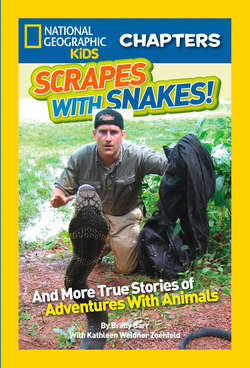Читать книгу National Geographic Kids Chapters: Scrapes With Snakes: True Stories of Adventures With Animals - Brady Barr - Страница 6
Оглавление
I was waist-deep in water in a muddy swamp. I was trying not to think about the leeches that might be crawling up my legs. Then—I spotted it! Stretched out in front of me was the biggest snake I had ever seen. It looked as long as a bus!
What was I doing here? My name is Brady Barr. I’m a zoologist (sounds like zoh-AH-luh-gist), a scientist who studies animals. I’ve studied all kinds of animals all over the world. My favorites are reptiles—really big reptiles.
I’ve worked with some real giants. I’ve wrestled crocodiles over 18 feet (5.5 m) long. I’ve captured 10-foot (3-m)-long lizards and turtles the size of small cars.
But until that day in the swamp, I’d never come across a giant snake. Although they’re among the biggest reptiles on the planet, they’re very hard to find. And scientists know surprisingly little about them.
The swamp where I met the giant snake was in northern India. I was there with my friend Gerry Martin, a reptile expert. We had teamed up to study a rare and endangered crocodilian (sounds like krah-koh-DIL-ee-un). But our croc project soon took an unexpected turn.
(photo credit 1.1)
Some snakes can swallow things three times the size of their own head! How do they do it? Snakes have really flexible jaws. Human jaws are attached to the skull like a door on hinges. All we can do is open and shut them. A snake’s lower jaw is not solidly attached at the chin, like ours is. Each side can move separately. A snake’s jawbone is attached to the skull by stretchy bands of tissue, almost like rubber bands. Using its curved teeth to grip its prey, the snake can slowly stretch out its jaws and move its mouth around its meal.
When Gerry and I got to the small village near our research site, none of the people wanted to talk about crocs. All they wanted to talk about were snakes. They said they had a big problem. Their cows were disappearing. And they believed a giant snake was eating them.
Did You Know?
In The Jungle Book, by Rudyard Kipling, the giant, 100-year-old snake named Kaa is an Indian rock python.
Holy cow! I thought. A cow-eating snake?
This was a story we just had to look into. A snake large enough to eat a cow would have to be a true giant. We’d heard stories like this before. But no scientists had ever been able to check them out. Maybe this was our chance to prove those stories were true.
The villagers told us the giant snake was eating their dogs, cats, and goats, too. They hoped maybe we could catch this snake and take it away to a safe place, far away from the village.
Gerry and I thought the snake was probably an Indian rock python. Rock pythons live in many different habitats. You can find them in low grasslands and on high mountain slopes. But the real giants usually stay near water.
The village was near the Geruwa (sounds like jeh-ROO-wah) River. Gerry wanted to go straight to the swampy area closest to the river, where the water was deepest. It was a great place for a big snake.
I really wanted to see this giant. But I wasn’t so sure I wanted to get into a deep, muddy swamp with it!
Ten-year-old Ramkrishna helped Gerry and me find the huge snake.
